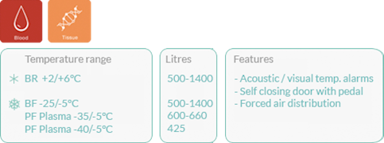Tissue
Facilitates storing of body liquids, organs, parts of organs or body tissues with the purpose of eventual infusion, administration or introduction into the body.
With "Tissue", product ranges are selected for their aptitude for storing your valuable items, often essential to your work.
Safeguarding the items is of great importance, therein ensuring accurate, stable and uniform temperatures in the storage chamber.
The following product ranges are selected for their ability to comply with the most stringent criteria, for the safe storage of tissue.
Helping keep samples safe - Gram BioLine products feature
- HIGH/LOW TEMPERATURE ALARMS
- FORCED AIR DISTRIBUTION
- HIGH/LOW TEMPERATURE ALARMS WITH VOLTAGE FREE CONTACT
BioBlood

The BioBlood range is similar to the top– of–the–range BioPlus, but with the control system and its software adapted to meet the particular requirements associated with the work carried out in blood banks. The interior fittings are specially designed for storing blood, plasma and other products used in blood bank operations.
Scoping Tissue
Newer and ever-more advanced technology in life-science is pushing the limit for what proper tissue storage conditions are.
With increasing demand, documentation requirements and higher specifications comes more specialized and bespoke storage solutions, able to deal with these requirements accordingly.
When defining proper storage conditions, temperature stability and uniformity are the main focal points.
Achieving this requires sufficient refrigeration capacity and a distribution method capable of providing the degree of accuracy needed to maintain the desired sample integrity. While constructing a refrigeration system capable of keeping the storage chamber and the samples inside, at the right temperature, is one thing - distributing the cold air in another.
"Fan assisted" seems to be the standardised term used to signify that the cold air is evenly distributed in the storage chamber, and therein uniformity achieved. But while a fan assisted refrigeration system is better equipped at distributing the cold than a static refrigeration system, it falls short in a normal use case. As the degree of occupancy in the storage chamber increases, air distribution impedance increases, ultimately resulting in air only being circulated in the very top, due to it "choosing" the path of least resistance.
Air distribution done right
The solution is to force the cold air throughout the cabinet. With forced air distribution, the cold air is channeled down a distribution plate at that back and out into the storage chamber, maximizing uniformity regardless of load, maintaining temperature stability and lowers recovery time after door openings.
Frozen tissue – e.g. bone, tendons, amnion. The storage condition requirements vary greatly from sample type to sample type, but common denominators are:
- CONTINUAL TEMPERATURE RECORDING (VIA A CHART RECORDER OR EXTERNAL MONITORING SYSTEM).
- AUDIBLE AND VISUAL ALARMS, PREFERABLY CONNECTED VIA THE VOLTAGE FREE CONTACT TO A MANNED SYSTEM.

